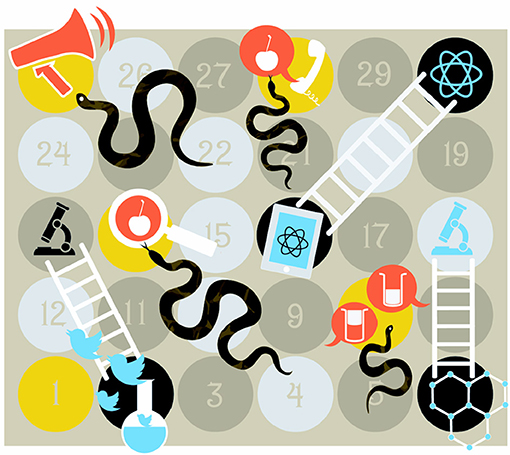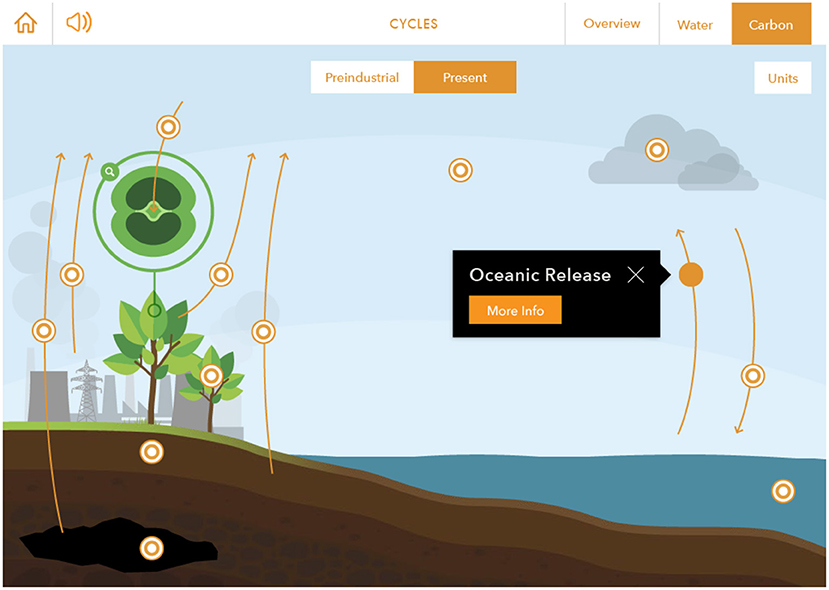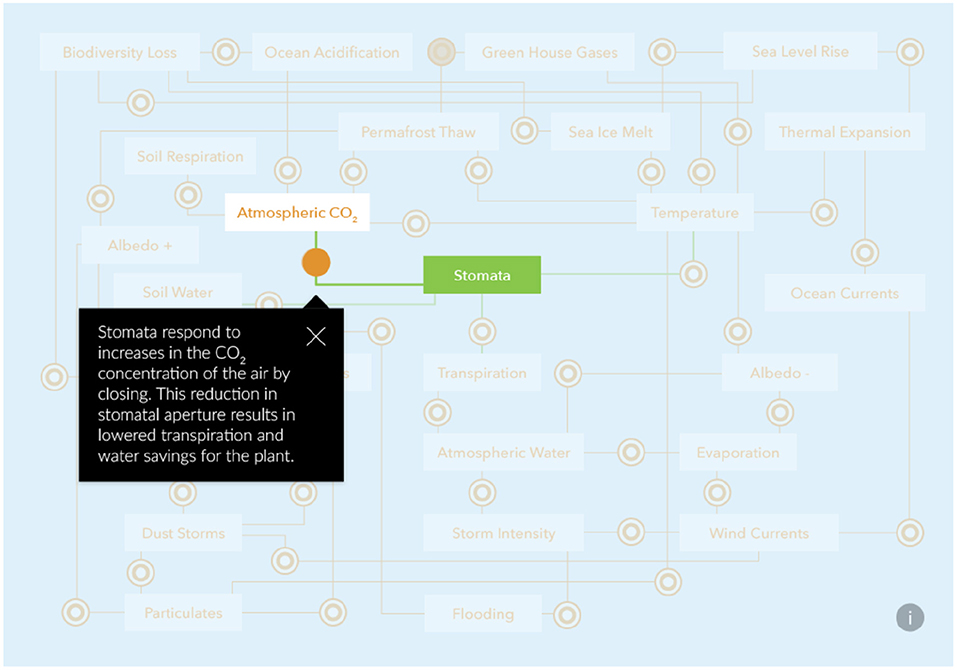Improving Climate-Change Literacy and Science Communication Through Smart Device Apps
- 1School of Science, Institute for Applied Ecology New Zealand, Auckland University of Technology, Auckland, New Zealand
- 2Department of Ecology and Evolutionary Biology, University of Toronto, Toronto, ON, Canada
- 3Sydney Institute of Marine Science, Mosman, NSW, Australia
Global change clearly one of the most important issues of the twenty-first century. Understanding of the impacts of large-scale human activities on communities, and how the natural world is being affected is arguably the largest area of research outside of the health sciences, and the two are intricately linked. Yet despite scientific consensus on human-induced climate change, many publics remain divided about its existence and impacts. More alarming still are the contradictory positions from leading governments around the world to address climate change. The most convincing scientific evidence is in vain if scientists fail to communicate key facts to policy makers or to the general public. Here, we investigate various “snakes” (pitfalls) and “ladders” (emerging opportunities) in science communication. Using the example of the “Global Change App,” we argue that science education apps may be a promising and underrated way forward to improve how information is communicated between scientists, students and citizens. Smart device apps could be an effective way translate research outputs beyond scientific journals, support science teaching, and make information on global change more translatable and relevant to the general public.
Global atmospheric CO2 levels are consistently above the threshold of 410 ppm (Scripps Institute of Oceanography, 2019) and temperature records show that the past 4 years (2015–2018) have been the fourth warmest on record (World Meteorological Organization, 2019). The ambitious agreement of reducing global warming to 2°C from November 2015 was initially ratified by the two single largest emitters of CO2 (China and the USA), but has since been abandoned by the USA. In a survey of American adults (August 15–25, 2014), 50% of respondents were not convinced that human activities were mainly responsible for climate change (Funk and Rainie, 2015). In the US, 31% of teachers pass on mixed ideas on the anthropogenic cause of climate change, e.g., emphasizing both the general consensus of scientists as well as leaving open the possibility of natural causes for global climate change (Plutzer et al., 2016). Such misconceptions are certainly not unique to the United States, but perhaps more surprising in a country which is also the source of some of the most convincing pieces of evidence on recent climate change. New tools and approaches are therefore needed to support climate change learning and literacy.
The disconnect between scientific consensus climate science and divergent public opinion stems from a complex set of social, educational, political, and media-related drivers (Lewandowsky et al., 2015). Reducing this disconnect requires the public to have a reasonable understanding of complex interactions between anthropogenic global change drivers and the environment. The scientific community needs help communicating these concepts in a way that is accessible and understandable to a general audience, which fundamentally starts in the education sector (Plutzer et al., 2016). For example, students discussed stratospheric ozone depletion as a driver for the enhanced greenhouse effect, when quizzed about global warming (Cordero et al., 2008). However, the two are entirely unrelated. Using the analogy of the widely known board game “snakes and ladders,” we show how various media channels can advance or set back public understanding of climate change facts.
The opinion-forming power of Twitter has increased enormously over the past decade (Chang, 2013). Before elected president of the US, Donald Trump tweeted “This very expensive GLOBAL WARMING bullshit has got to stop. Our planet is freezing, record low temps, and our GW scientists are stuck in ice” (https://twitter.com/realDonaldTrump/status/1090074254010404864). And more recently: “In the beautiful Midwest, wind-chill temperatures are reaching minus 60 degrees, the coldest ever recorded. In coming days, expected to get even colder. People can't last outside even for minutes. What the hell is going on with Global Warming? Please come back fast, we need you!” (https://twitter.com/realDonaldTrump/status/1090074254010404864). Both messages suffer from misinterpretation (field 8 in Figure 1), sensationalism (field 25), and oversimplification (field 28). The importance of scientists using Twitter more often has recently been shown by Côté and Darling (2018): they find that the proportion of non-scientists among the followers increases rapidly once 1,000 followers have been reached. For Twitter to become a “ladder” in climate change communication (Figure 1), scientists should be encouraged to enhance their social media presence. This more direct information flow between scientists and the general public can also be achieved using other social media (e.g., FaceBook, McClain, 2017).

Figure 1. Playing the snakes and ladders of climate science communication. The snakes on the board represent the poor dissemination of scientific knowledge by some main-stream media outlets leading to an ill-informed public through mechanisms including (but not limited to); 8: misinterpretation of science concepts by the media; 14: cherry picking of information; 25: sensationalism; and 28: oversimplification of information. The ladders represent the elevation of robust scientific climate evidence through mechanisms including (but not limited to); 2: scientists using social media platforms, such as Twitter; 6: capitalizing on academic networks to share teaching tools, and 16: the development of science education apps.
Another potentially underrated “ladder” in the game of science communication could be the use of smart device apps (field 16 in Figures 1, 2). Plutzer et al. (2016) argue for the broad use and further development of easily accessible material that sets the standard for the global, unbiased scientific consensus. Examples are the smart device app “Skeptical Science” featuring counter arguments against the most common climate denialists' punch lines (Skeptical Science, 2016).

Figure 2. Screenshot from the Global Change App. The user interactively learns about the global carbon and water fluxes and pools, how human activity affects them, and how they are interrelated.
Another app, Global Change (Borrelle et al., 2016, Figure 2), provides an accessible approach to improving the general public's knowledge on the processes that drive climate change. It was designed through a collaboration of scientists and digital creatives as an education platform to improve tertiary-level student's fundamental knowledge of the global carbon and water cycles, and how they are impacted by human activity. The concept of the app is based on distilling the most critical pieces of information in a very clear and concise way. Misinformation in climate science and other areas prone to widespread misconception often originates from relatively easy to debunk myths (Lewandowsky et al., 2012). Therefore, the app is designed as a compact and easy to navigate tool with an emphasis on conveying how processes are linked rather than describe processes in isolation. After a brief introductory animation video, the user can explore three main pages. The first one explains the pivotal role of leaf pores in affecting and responding to global climate. The goal here is to clarify the direct effect of CO2 on plants, which is hugely important in shaping our climate, but often overlooked in favor of the more apparent greenhouse effect caused by the same gas. The second page focusses on the global carbon and water cycles, with an option to compare pre- and post-industrial scenarios (Figure 2). The emphasis here is on the clarity around the often confounded pools vs. fluxes, particularly regarding the carbon cycle (Asshoff et al., 2010; Leuzinger and Hättenschwiler, 2013). Lastly, there is a page that allows the user to click on nodes that connect certain phenomena with environmental parameters, e.g., the mechanistic link between stomata and atmospheric CO2 (Figure 3).

Figure 3. Screenshot of the “connections” page of the app. The user can navigate through the many connections between the environment and parameters affected by humans. Some information boxes contain links to external content.
In beta testing of the Global Change app, German high school students were faced with the statement: “I can explain the effect of rising CO2 at the level of the plant.” While before using the app independently for a week, 70.6% ticked “tend to disagree,” after 1 week of using the app, 77.3% ticked “tend to agree.” Thus, students seem receptive to using smart device apps as part of their learning (Woodcock et al., 2012). Such apps could help both in circumstances where teachers struggle against widespread climate skepticism among students (https://www.nytimes.com/2017/06/04/us/education-climate-change-science-class-students.html). Curricula would benefit from having smart device science education apps firmly integrated, either at the high school or tertiary level (Borrelle et al., 2016; Zydney and Warner, 2016).
The app is designed to be used by a large span of age classes, ranging from children in intermediate school to adults. Intergenerational learning is an underutilized pathway to enhance climate literacy and science communication (Lawson et al., 2018). Children are not only easiest to reach through schools, but are well-equipped to navigate climate change communication due to being considered more trustworthy, a neutral pathway for information dissemination, and an ideal intermediary to also enhance their own family members' awareness. The Alliance for Climate Education asserts that teenagers are the most influential in changing their parents' minds on issues such as climate change (https://acespace.org/). Therefore, reaching students in the classroom may also assist in enhancing climate change literacy for the students themselves and the public more broadly. With the recent climate strikes, enormous momentum has been observed in this intergenerational exchange and consensus on climate change (Schiermeier et al., 2019).
Creating smart device apps to promote climate change science could be an important step in broadening and deepening climate knowledge of children, students and the public, but how can we ensure such apps are used? First, we have to acknowledge the digital divide where not everyone has access to technology or smart devices (Ragnedda and Muschert, 2013). Only just over half the world's population currently have access to smart devices (e.g., cell phones, tablets; Statista, 2019), but the number is increasing rapidly, even in poorer countries. In the US, 77% (92% in the age bracket 18–29) of the population now own a smart device (http://www.pewinternet.org/fact-sheet/mobile/). The reach of climate change-focused apps is therefore substantial and growing, giving access to up-to-date scientific information, potentially improving general knowledge of climate change issues. A promising pathway to encourage active engagement, particularly of younger people, in app use is to gamify them. Gamification has become an important and rapidly growing feature that may provide a huge incentive for the use of apps with an otherwise academic touch (Morford et al., 2014; Scharl et al., 2016). Another opportunity can be the dissemination of such apps with social media (e.g., Bombaci et al., 2016), and utilizing academic networks, for example sharing teaching resources with colleagues (field 6 in Figure 1). In the combat against fake news, alternative facts, and pseudoscience, smart device apps with the signature of scientists certainly have the potential to overcoming the confusion that arises from misinterpretation, sensationalism, cherry picking, and oversimplification of scientific concepts often translated in the mainstream media (Boykoff, 2007; snakes in Figure 1).
In conclusion, while difficulties remain in using multimedia mobile applications to enhance basic ecological understanding (Nisbet et al., 2010), we argue that smart device apps will become an increasingly important tool in promoting awareness and science literacy, particularly of global change related issues. This opportunity should not be overlooked by the scientific community. Once such smart device tools have been developed, their dissemination and use by students and the public must not only be promoted, but also form the subject of ongoing research, which, apart from mere download numbers, is very limited to date (Borrelle et al., 2016). We argue that funding should be made available to specifically develop and research science communication via smart device apps. Given recently proposed restrictions of American scientific agencies from disseminating climate change related evidence (Witze, 2017), it is even more important for scientists to find ways to share global change evidence with the public. The example presented here is a small first step toward developing more interactive smart device apps, using tools such as gamification and social media to spread science rather than myths. We are convinced that such apps can be a powerful tool to help dispel widespread inaccuracies of climate change related issues, providing ladders rather than snakes in the urgent game of climate science communication.
Author Contributions
SL and SB drafted this work. RJ helped refining the text.
Conflict of Interest
The authors declare that the research was conducted in the absence of any commercial or financial relationships that could be construed as a potential conflict of interest.
References
Asshoff, R., Riedl, S., and Leuzinger, S. (2010). Towards a better understanding of carbon flux. J. Biol. Educ. 44, 180–184. doi: 10.1080/00219266.2010.9656218
Bombaci, S. P., Farr, C. M., Gallo, H. T., Mangan, A. M., Stinson, L. T., Kaushik, M., et al. (2016). Using Twitter to communicate conservation science from a professional conference. Conserv. Biol. 30, 216–225. doi: 10.1111/cobi.12570
Borrelle, S. B., Frielick, S., Asshoff, R., and Leuzinger, S. (2016). “The global change app: the creative transformation,” in Handbook of Research on Mobile Devices and Applications in Higher Education Settings, eds L. Briz-Ponce, J. A. Juanes-Mendez, and F. J. G. Peñalvo (Hershey, PA: IGI Global), 140.
Boykoff, M. T. (2007). Flogging a dead norm? Newspaper coverage of anthropogenic climate change in the United States and United Kingdom from 2003 to 2006. Area 39, 470–481. doi: 10.1111/j.1475-4762.2007.00769.x
Côté, I. M., and Darling, E. S. (2018). Scientists on Twitter: preaching to the choir or singing from the rooftops?. FACETS 3, 682–694. doi: 10.1139/facets-2018-0002
Chang, S. P. (2013). Does Twitter motivate involvement in politics? Tweeting, opinion leadership, and political engagement. Comput. Hum. Behav. 29, 1641–1648. doi: 10.1016/j.chb.2013.01.044
Cordero, E. C., Todd, A. M., and Abellera, D. (2008). Climate change education and the ecological footprint. B. Am. Meteorol. Soc. 89, 865–872. doi: 10.1175/2007BAMS2432.1
Funk, C., and Rainie, L. (2015). Public and Scientists' Views on Science and Society: Pew Research Center. Available online at: http://www.pewinternet.org/2015/01/29/public-and-scientists-views-on-science-and-society (accessed October 17, 2016).
Lawson, D. F., Stevenson, K. T., Peterson, M. N., Carrier, S. J., Strnad, R., and Seekamp, E. (2018). Intergenerational learning: are children key in spurring climate action? Glob. Environ. Change 53, 204–208. doi: 10.1016/j.gloenvcha.2018.10.002
Leuzinger, S., and Hättenschwiler, S. (2013). Beyond global change: lessons from 25 years of CO2 research. Oecologia 171:639. doi: 10.1007/s00442-012-2584-5
Lewandowsky, S., Ecker, U. K., Seifert, C. M., Schwarz, N., and Cook, J. (2012). Misinformation and its correction: continued influence and successful debiasing. Psychol. Sci. Public Interest 13, 106–131. doi: 10.1177/1529100612451018
Lewandowsky, S., Oreskes, N., Risbey, J. S., Newell, B. R., and Smithson, M. (2015). Seepage: climate change denial and its effect on the scientific community. Glob. Environm. Change 33, 1–13. doi: 10.1016/j.gloenvcha.2015.02.013
McClain, C. R. (2017). Practices and promises of Facebook for science outreach: becoming a “Nerd of Trust”. PLoS Biol. 15:e2002020. doi: 10.1371/journal.pbio.2002020
Morford, Z. H., Witts, B. N., Killingsworth, K. J., and Alavosius, M. P. (2014). Gamification: the intersection between behavior analysis and game design technologies. Behav. Anal. 37, 25–40. doi: 10.1007/s40614-014-0006-1
Nisbet, M. C., Hixon, M. A., Moore, K. D., and Nelson, M. (2010). Four cultures: new synergies for engaging society on climate change. Front. Ecol. Environm. 8, 329–331. doi: 10.1890/1540-9295-8.6.329
Plutzer, M., McCaffrey, A. L., Hannah, J., Rosenau, J., Berbeco, M., and Reid, A. H. (2016). Climate confusion among US teachers. Science 351, 664–665. doi: 10.1126/science.aab3907
Ragnedda, M., and Muschert, G. (eds.). (2013). The Digital Divide: The Internet and Social Inequality in International Perspective. New York, NY: Routledge.
Scharl, A., Föls, M., Herring, D., Piccolo, L., Fernandez, M., and Alani, H. (2016). “Application design and engagement strategy of a game with a purpose for climate change awareness,” in International Conference on Internet Science (Cham: Springer), 97–104. doi: 10.1007/978-3-319-45982-0_9
Schiermeier, Q., Atkinson, K., Mega, E. R., Padma, T. V., Stoye, E., Tollefson, J., et al. (2019). Scientists worldwide join strikes for climate change. Nature 573, 472–473. doi: 10.1038/d41586-019-02791-2
Scripps Institute of Oceanography (2019). The Keeling Curve. San Diego, CA. Available online at: https://scripps.ucsd.edu/programs/keelingcurve/ (accessed March 1, 2019).
Skeptical Science (2016). Skepical Science iPhone app. Available online at: https://skepticalscience.com (accessed March 10, 2019).
Statista (2019). The Statistics Portal. Available online at: http://www.statista.com/statistics/330695/number-of-smartphone-users-worldwide/ (accessed March 10, 2019).
Woodcock, B., Middleton, A., and Nortcliffe, A. (2012). Considering the Smartphone Learner: developing innovation to investigate the opportunities for students and their interest. Stud. Engage. Exp. J. 1, 1–15. doi: 10.7190/seej.v1i1.38
World Meteorological Organization (2019). Available online at: https://public.wmo.int/en/media/press-release/wmo-confirms-past-4-years-were-warmest-record (accessed March 10, 2019).
Keywords: global change, digital education, gamification, smart device app, science app
Citation: Leuzinger S, Borrelle SB and Jarvis RM (2019) Improving Climate-Change Literacy and Science Communication Through Smart Device Apps. Front. Educ. 4:138. doi: 10.3389/feduc.2019.00138
Received: 19 March 2019; Accepted: 11 November 2019;
Published: 27 November 2019.
Edited by:
Xiaoxun Sun, Australian Council for Educational Research, AustraliaReviewed by:
Pradeep Nair, Central University of Himachal Pradesh, IndiaJames Damico, Indiana University, United States
Copyright © 2019 Leuzinger, Borrelle and Jarvis. This is an open-access article distributed under the terms of the Creative Commons Attribution License (CC BY). The use, distribution or reproduction in other forums is permitted, provided the original author(s) and the copyright owner(s) are credited and that the original publication in this journal is cited, in accordance with accepted academic practice. No use, distribution or reproduction is permitted which does not comply with these terms.
*Correspondence: Sebastian Leuzinger, sebastian.leuzinger@aut.ac.nz
 Sebastian Leuzinger
Sebastian Leuzinger Stephanie B. Borrelle1,2
Stephanie B. Borrelle1,2